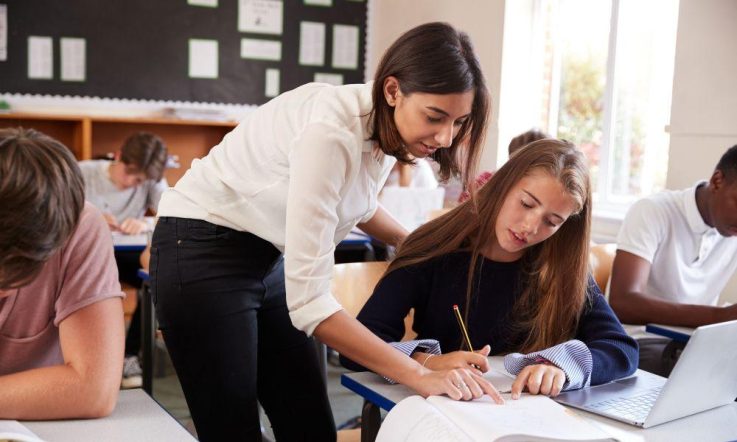Picture this scenario: you’re teaching a mathematics lesson, helping to guide students through the content and activities, but there’s very little feedback in the way of questions or requests for clarification. Does this mean your students understand? Or could it mean that they’re not comfortable speaking up in class when they’re unsure of something being taught?
The latest Programme for International Student Assessment (PISA) insights report (OECD, 2024) explores student use of learning strategies, motivation for learning and self-confidence. Topics include whether students ask questions when they don’t understand, their level of learning anxiety, and checking work and homework for mistakes.
In his foreword to PISA 2022 Results Volume V: Learning Strategies and Attitudes for Life, OECD Director for Education and Skills, and Teacher columnist, Andreas Schleicher comments: ‘As this report shows, learning strategies, motivation, and self-belief tend to go hand-in-hand.
‘Low-performing students face a double challenge: they struggle with both academic achievement and a lack of confidence in their ability to learn. Meanwhile, even high-performing students are not always well-prepared for lifelong learning. Identifying and building on students’ strengths – whether in terms of learning strategies, motivation, or self-belief – can create multiple pathways to success.’
PISA measures the knowledge and skills of 15-year-olds in mathematics, science and reading. It also includes a student and principal questionnaire. All the 2022 survey responses relate to mathematics, as that was the core assessment domain in this latest test cycle.
The Volume V report notes that ‘building young people’s resilience in a changing world requires an aptitude for lifelong learning’. In other words, thinking about your own students, how are you helping them to prepare for learning beyond compulsory schooling? ‘The data shed light on how students adopt and use key learning strategies; how motivated they are to learn; and how confident they are that they can acquire, synthesise and employ new knowledge through study and effort.’
The near 300-page report contains a wealth of information from across the OECD participating countries and partner economies on a range of issues. Here, we’ve picked out just 3 areas for teachers and school leaders to reflect on.
Learning strategies: Asking questions
PISA data show that less than half of students frequently ask questions when they do not understand something being taught in mathematics (i.e. over half of the time they have doubts). On average, only 47% of students frequently seek clarification …
The highest percentage was in Iceland, where just over 61% of students reported asking questions more than half the time when they are not sure of the material being taught. At the other end of the scale, fewer than one in 3 students do this in Macao (China), Poland, Chinese Taipei and Thailand. In Australia, 54% of students report doing this.
Why is this important? Asking questions is a crucial part of learning, so classroom teachers need to create a safe and inquisitive learning environment where students feel confident to speak up and ask questions when they don’t understand what is being taught. The report explains that by encouraging your students to ask questions, you’ll also help them tackle challenges, get support if they need it, and foster a positive learning mindset (the belief that it’s possible to improve their knowledge, understanding and skills).
According to PISA 2022 data, students who reported asking questions ‘frequently outperform those who do not in almost all countries/economies, even after accounting for the socioeconomic profile of students and schools’.
Those operating below Level 2 in mathematics are termed low performers. On average across the OECD, less than 40% of low performers reported frequently asking questions when they do not understand the material. ‘This suggests that those who are likely to need more support are more reluctant to openly ask questions when they are unsure of something they are being taught,’ the report notes.
Predispositions to learning: Mathematics anxiety
The anxiety students say they experience doing mathematics has grown since 2012, the last time mathematics was PISA’s focus subject. This can impact their wellbeing and readiness for lifelong learning.
On average, across the OECD, the percentage of students who ‘agreed’ or ‘strongly agreed’ that they get very nervous when doing mathematics problems increased from 31% in 2012 to 39% in 2022. Most countries and economies recorded an increase – the biggest being Turkey (39% to 56%), Iceland (18% to 34%) and Sweden (18% to 33%). In Australia, the increase was from 29% to 35%.
However, it was the opposite trend in a handful of countries. Korea recorded the biggest drop in anxiety between 2012 and 2022 (44% to 32%), and student anxiety levels also fell in Thailand (65% to 62%) and Singapore (37% to 35%).
Low performers had higher levels of mathematics anxiety than those performing at or above Level 3 (termed skilled performers in the report), and girls had higher levels of mathematics anxiety than boys – even among top-performers. There’s also a link with the topic discussed above: students who are less anxious ask more questions when they do not understand the material being taught.
So, what kind of worries do students have? The report shares two-thirds (65%) of students were worried about getting poor marks in mathematics and more than half (55%) felt anxious about ‘failing’ in the subject. But it adds 40% said they felt ‘nervous, helpless or anxious’ while solving problems or doing their mathematics homework ‘meaning that students are anxious simply dealing with the subject and not just because they are worrying about failing’.
A supportive and safe school environment, and positive relationships between teachers and students can have an impact. The PISA Volume II report (OECD, 2023) found students ‘who scored higher in mathematics reported less anxiety towards mathematics when they perceived their teachers to be more supportive, after accounting for students’ and schools’ socioeconomic profile’. Support outside school also has a positive impact – students who enjoyed more support from their families report feeling less mathematics anxiety.
Learning strategies: Checking work and homework
Data from PISA 2022 show that 64% of students, on average, “agreed” or “strongly agreed” with the statement “I like to make sure there are no mistakes” … Skilled performers have especially cultivated this habit of double-checking for errors as they more consistently “agreed” or “strongly agreed” that they do so (71% on average) in most surveyed countries and economies.
Double-checking for mistakes is a common control or self-monitoring learning strategy. The PISA survey asked students about checking to make sure there are no mistakes in their work, and a separate question about whether they carefully check homework before turning it in.
On the question of checking school work for mistakes, as noted above, the OECD average is 64%. Korea recorded the highest percentage (90% of students), followed by Mongolia (87%) and Indonesia (85%). In Australia, 57% of students said they like to make sure there are no mistakes in their work. At the other end of the scale, 50% of students in Macao (China) reported the same, 51% in Croatia and 52% in both Hong Kong (China) and New Zealand.
The Volume V report notes the data also show significant variation for students across OECD countries and partner economies in the habit of carefully checking homework before turning it in. The average across the OECD was just 44% of students.
‘In some countries like Cambodia, Indonesia, and Uzbekistan about three-quarters of students do this while in Finland, the Netherlands, and Latvia, the percentage drops below 30%,’ it reads. In Australia, only 36% of students reported carefully checking their homework before submission.
Unlike some of the other survey results, the gap between skilled performers (46%) and low performers (42%) is relatively small.
The report also points out it’s important to take into account how homework is viewed in different systems, as this can influence how students approach it. For example, is it an important part of a students’ overall grading or learning?
In conclusion, it cites several studies reflecting the advice that, ‘to provide the greatest benefits, homework and the habit of double-checking homework should be tailored to students’ actual needs rather than mechanically implemented without consideration of their effectiveness’.
References
OECD. (2024). PISA 2022 Results (Volume V): Learning Strategies and Attitudes for Life. PISA, OECD Publishing. https://doi.org/10.1787/c2e44201-en.
OECD. (2023). PISA 2022 Results (Volume II): Learning During – and From – Disruption. PISA, OECD Publishing. https://doi.org/10.1787/a97db61c-en
Are your students comfortable asking questions when they don’t understand something in class? Is this something you’ve spoken to them about?
How are you creating a safe and inquisitive learning environment? Thinking about students who don’t feel comfortable, how could you make the process easier for them?



